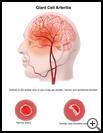
Giant Cell Arteritis
________________________________________________________________________
KEY POINTS
- Giant cell arteritis is a disorder that causes the arteries in the temple area of your scalp to become swollen, narrow, and sometimes blocked.
- Giant cell arteritis is commonly treated with medicine.
- It is important to treat the disease as early as possible to prevent complications, including loss of vision.
________________________________________________________________________
What is giant cell arteritis?
Giant cell arteritis is a disorder that causes some of your arteries, usually those on the sides of your face between your eye and ear (the temple area), to get swollen, narrowed, and sometimes completely blocked. It can affect any artery in the body. Arteries are the blood vessels that carry blood from the heart to the rest of the body. This disease is also called temporal arteritis when it affects the artery in your temple.
It is important to diagnose and treat this disease as early as possible because it can cause a stroke or sudden loss of vision.
What is the cause?
The cause of this disorder is not known. It happens most often in people who are 60 to 80 years old. Women are affected more often than men. It is more common among people of northern European descent. Some researchers believe that this disorder may be inherited, which means that it is passed from parents to children through their genes. Genes are inside each cell of your body. They contain the information that tells your body how to develop and work.
Other possible causes include a reaction to something in your environment or an autoimmune response, which means that your body's defenses against infection mistakenly attack your body's own tissue.
What are the symptoms?
Symptoms may include:
- Headache
- Swelling of the blood vessels on the side of your forehead
- Tenderness of the scalp, usually over your temples
- Pain in the jaw when you chew, swallow, or talk
- Fever
- Feeling tired all the time
- Vision problems, including blurred vision, double vision, or blindness
About half of the people who have giant cell arteritis also have polymyalgia rheumatica (PMR). PMR is a disorder that causes severe stiffness and pain in the muscles of your neck, shoulders, lower back, and hips.
How is it diagnosed?
Your healthcare provider will ask about your symptoms and medical history and examine you.
Tests may include:
- Blood tests
- A biopsy, which is the removal of a small sample of tissue from an artery for testing
How is it treated?
Giant cell arteritis is treated with steroid medicine. This medicine can relieve symptoms in days to weeks. Using a steroid for a long time can have serious side effects. Take steroid medicine exactly as your healthcare provider prescribes. Don’t take more or less of it than prescribed by your provider and don’t take it longer than prescribed. Don’t stop taking a steroid without your provider's approval. You may have to lower your dosage slowly before stopping it.
In general, the condition resolves completely in most cases. Treatment typically lasts about 2 years, but can last for 5 years or more. Damage to the eyes is often permanent. If symptoms come back, you may need more treatment. Some people must take medicine for many years.
How can I take care of myself?
Ask your provider if there are any lifestyle changes you need to make, such as diet changes. Talk with your provider about your risk for developing lifelong disease of your large arteries.
Follow the full course of treatment prescribed by your healthcare provider. Ask your provider:
- How and when you will get your test results
- How long it will take to recover
- If there are activities you should avoid and when you can return to your normal activities
- How to take care of yourself at home
- What symptoms or problems you should watch for and what to do if you have them
Make sure you know when you should come back for a checkup. Keep all appointments for provider visits or tests.

